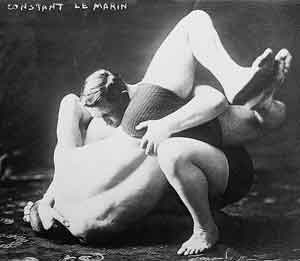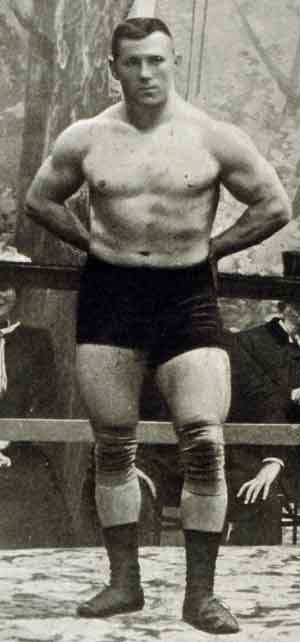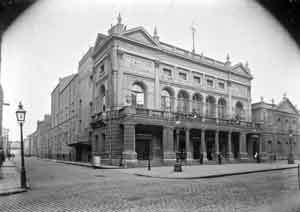‘THE WRESTLING RAGE’—THE WORLD CHAMPIONSHIP TOURNAMENT IN DUBLIN, 1907
Published in Features, Issue 2 (March/April 2023), Volume 31By Ronan Mulhaire

Above: The ‘Belgian Tiger’, Constant le Marin—‘the most perfect specimen of manhood it is possible to conceive’—was backed by the Empire Theatre in the 1907 tournament.
Between the close of the nineteenth century and the beginning of the First World War professional wrestling, in the words of Matthew Lindaman, ‘enjoyed a status unparalleled among other sports of the time’. This stemmed from a rise in mass culture, nationalism and fin de siècle anxieties about masculinity and degeneracy. Ireland was no exception in this regard, though very little has been written about the history of professional wrestling in this country to date.
Wrestling’s popularity in the United Kingdom was buoyed by the arrival of George Hackenschmidt in early 1902. Born in Tartu, Estonia, in July 1877, Hackenschmidt, the most famous wrestler of his age, made his name by winning an amateur tournament in Vienna in 1898. Turning professional in 1900, he undertook a tour of the United Kingdom under the management of Charles Blake Cochran (1872–1951). Huge crowds flocked to watch ‘the Russian Lion’ compete; as the Manchester Evening News noted in October 1902, Hackenschmidt succeeded in ‘widening the scope of interest [in the sport] far beyond what old wrestlers are accustomed to’.
Looking to cash in on wrestling’s popularity, theatre managers engaged a coterie of international stars in wrestling contests. Irish audiences flocked to see the American Jack Carkeek, ‘Hindoo champion’ Ka Houta, Japanese jiu-jitsu exponent Raku and others. Newspapers reported large turnouts. The Empire Theatre (now the Olympia Theatre), Dublin, was, according to Sport, ‘literally packed to overflowing’ when W.A. Allan fought Sergeant Doubleday in December 1906. The Dublin Evening Mail told of ‘large audiences … attracted by the wrestling fever’ in September of that year. The Irish Independent commented on the heterogeneity of the crowds in January 1907: ‘The audience included all sorts and conditions. Ladies in furs occupied the boxes, military officers held seats in front, young men and their sweethearts were up in the second circle … Old and young were amongst the spectators.’
WRESTLING IN THE EARLY TWENTIETH CENTURY

Above: George Hackenschmidt (1877–1968), ‘the Russian Lion’ (although he was a German born in Estonia)—widely regarded as wrestling’s ‘world champion’ in this period. (Alamy)
Professional wrestling in the late nineteenth and early twentieth centuries bore little resemblance to the choreographed melodramatic athletic performances of today. Most wrestlers in this period were, unlike the majority of their modern counterparts, well versed in the fundamentals of the sport. That said, already by the 1890s we see the seeds from which today’s sensationalised ‘contests’ grew. The two decades on either side of 1900 were a watershed moment. As Scott Beekman writes, ‘During this period … wrestling became increasingly dominated by theatrically minded promoters and hucksters concerned with profit more than honest competition’. These decades marked ‘the last gasp of authentic competitive professional wrestling’. Legitimate contests were increasingly scarce. That the legitimacy of wrestling contests could be somewhat suspect was widely acknowledged. A piece that ran in the Dublin Evening Mail in August 1904 claimed that ‘On the Continent … the music-hall wrestler is an institution; in some cases his performances may be genuine, but the great majority of the contests … are nothing more than exhibition bouts arranged between the champion and members of his troupe’. Press reports sometimes stressed that individual contests were ‘genuine’; Karl Victor and W.A. Allan’s May 1907 bout was promoted as a ‘thoroughly genuine affair’ in the Dublin Daily Express.
WRESTLING AND MASCULINITY
By the late nineteenth century fears about physical and moral degeneration, which stemmed from the processes of urbanisation and industrialisation, were widespread. These anxieties manifested themselves in concerns about national decay and gender distinctions. Indeed, the two often overlapped, with ‘manliness’ and virility seen as a barometer of the nation’s health. Newspapers were replete with advertisements for quack medical devices designed to restore lost ‘vigour’ and strength, capitalising on concerns about being ‘weak’. The evils of masturbation were counselled against, and it was believed that the ‘weak semen’ of masturbators produced weak, sickly children. For many, the figure of the clerk became the embodiment of degeneration, his physical atrophy the consequence of long days confined indoors, while the Dublin Daily Express published the warnings of eugenics advocate Sir James Crichton-Browne that city life would, in time, ‘dry up the reservoirs of strength in the population’. On St Patrick’s Day 1905 in Monasterevin, Co. Kildare, Revd Patrick Dineen delivered a lecture entitled ‘National Regeneration’ which tied together the themes of nationalism, religion and degeneracy. He derided ‘large towns and cities’ as ‘the power-houses of disease and degeneracy’, and heralded early Christian rural society as one in which the ‘moral and physical health of our people … reach[ed] a high level’.
Concerns over physical degeneracy and unmanliness gave rise to organisations like the Boy Scouts in 1909, and physical exertion was, amongst other things, seen as a way of counteracting degeneracy. The winter 1886 edition of the Irish Cyclist and Athlete praised the ‘tendency of … young men … to spend their leisure time in manly exercises’, for ‘when these outdoor sports fail our decay as a nation will commence’. Wrestling’s popularity stemmed from this increased obsession with physical culture. Wrestlers, with their muscular bodies and their skill and dedication to their sport, epitomised the ideal man. Their strength and physical appearance were the antithesis of the wiry office clerk. Wrestlers, as the ‘champion’ of a country, embodied that nation’s manhood; victory served as a rebuttal to any suggestions of national degeneracy. As the ‘wrestling rage’ gathered pace, wrestler-penned newspaper articles began to appear in an effort to further popularise the sport as a mode of physical exercise. W.A. Allan praised the ‘wrestler as the beau ideal of athletic excellence’ in his February 1907 piece entitled ‘How to get strong’, which appeared in the Dublin Evening Mail: ‘he is mentally quick and active … temperate in … habits and mode of living’. An advertisement for ‘Phosferine: The Greatest of all Nerve Tonics’, endorsed by Hackenschmidt, appeared in a number of Irish publications in 1904–5, promising to cure, amongst other things, ‘mental exhaustion’ and ‘premature decay’.
THE WORLD CHAMPIONSHIP TOURNAMENT
In early June 1907, the Empire Theatre announced its intention to ‘institute a world’s championship wrestling tournament to decide the wrestling supremacy of the world’, avowedly seeking to capitalise on ‘the great interest manifested in wrestling in Ireland’. The question of a wrestling ‘world championship’ in this early period of the sport’s history is somewhat intractable. It was common at this time for a wrestler to be billed as a ‘champion’, though many such claims were fanciful and occasionally a wrestler’s claims to be ‘champion’ of a particular place were mocked in the press. Physical championship belts did exist in this period, though they were somewhat less ubiquitous than the individuals styled as ‘champions’. Without a central organisational body over the sport, promoters and wrestlers alike were free to employ the ‘champion’ moniker as liberally as they wished, and any attempts to establish a universally recognised world champion were futile. Hackenschmidt certainly laid claim to being the ‘world champion’ in this period; his victories over Ahmed Madrali in London in January 1904 and April 1906, and over Tom Jenkins in New York’s Madison Square Garden in May 1905, were widely regarded as ‘world championship’ bouts.
It was thus possible, in this environment, for George Marsh, the manager of the Empire, to unilaterally announce the holding of a ‘world championship’ wrestling tournament. The rules of the tournament were straightforward enough: the Empire would nominate a wrestler to take on all comers and, when defeated, his conqueror would take his place. The competition would continue until all challengers had competed. The winner was to be presented with a gold medal and £300, and bouts were to take place under Graeco-Roman rules (whereby no holds below the waist were permitted). The wrestler backed by the Empire was a young Belgian, Constant Le Marin, the ‘most perfect specimen of manhood it is possible to conceive’.
WAR OF WORDS
After some delays, the tournament commenced on 1 July. Hackenschmidt was due to arrive in Dublin a few days later and was scheduled to appear exclusively in the Theatre Royal from Monday 8 July. Around this time the Evening Mail announced that Hackenschmidt had deposited £300 with it, offering to meet Le Marin in a neutral venue, with a sum of money going to Dublin charities if the match were to come about.
Thus began a war of words between the two camps, and between the respective theatre-owners, which played out in the national press. As Paul Rouse has noted, the increasing commercialisation of sport ‘was epitomized by the widespread development of a sporting press’, the two having an almost symbiotic relationship: ‘There was a great mutual benefit of a sporting world full of heroic men performing almost magical feats spun by the media and sold to the enthralled public’. Newspapers provided a platform for wrestlers to issue challenges and build excitement for upcoming bouts. The large audiences that packed the Empire were likely equally enthusiastic consumers of newspaper reports of the various wrestling bouts held in Dublin and beyond.
In any case, Hackenschmidt and his handlers did not have to wait long for a response from Le Marin’s camp: Le Marin did not possess the same financial backing as the ‘Russian Lion’ and could not come up with the funds himself. W.A. Allan, Le Marin’s manager, portrayed the whole affair as a publicity stunt in a letter to the Evening Mail: ‘Hackenschmidt hits the poor man with the diplomatic weapon £ s. d. because he is conscious Le Marin cannot follow him’. The Empire management made it clear that they were not in a position to sponsor Le Marin. A few days later, both Allan and Marsh, in letters published in the Mail and elsewhere, protested that the Empire, as a limited company, was debarred by their articles of association from paying the £300 on behalf of Le Marin.
While Hackenschmidt ran through all challengers in the Royal, the ‘Belgian Tiger’ savaged his opponents in the Empire, without any further developments. Then on 9 July the newspapers ran with two stories: £300 had been deposited on behalf of Le Marin, in order that a match would finally take place in Ballsbridge, and Hackenschmidt, his stake money not having been matched for a week, had withdrawn his £300. Insults were traded in the press, each side depicting the other as cowardly.
GRAECO-ROMAN OR ‘NO HOLDS BARRED’?
A few days later, however, both wrestlers lodged £300 and proposed a date for a contest: 26 August, the week of the Dublin Horse Show. Yet further hiccups would arise. George Marsh, in a short speech at the Empire on 10 June, hoped that Hackenschmidt would have no difficulty in agreeing to Graeco-Roman rather than Catch-as-Catch-Can rules (no holds barred) for the proposed bout. Predictably, Hackenschmidt objected. In a lengthy interview published in the Dublin Evening Telegraph, Hackenschmidt insisted that he had ‘retired from the Graeco-Roman arena … and … don’t intend to go back to it’. He also took aim at Le Marin’s credentials, claiming that at a recent tournament in Paris the Belgian had ‘been beaten by several men’. ‘Why should I wrestle a man who has been recently beaten’, he asked. ‘To beat such a man … would not mean glory.’ The two continued to perform before packed crowds in their respective theatres, but the public clamour for a contest grew. When on 12 July Hackenschmidt’s manager issued his usual public challenge he was, noted the Freeman’s Journal, ‘met with considerable interruptions, amidst which strikingly audible cries of “What about the Empire?” predominated’.
On 13 July the Dublin Evening Telegraph published an interview with Le Marin in which the young Belgian sought to refute many of the claims made by Hackenschmidt: Graeco-Roman was the ‘style in which Hackenschmidt won his championship’, whereas Le Marin had never previously competed under Catch rules. Further, while Le Marin had indeed been beaten in Paris, he had ‘only been defeated by [Georg] Lurich and Sbysko Cyganiewiez, both of whom had defeated Hackenschmidt previously’.
Finally, in an audacious attempt at publicity, Le Marin, flanked by Allan and the rest of his entourage, entered the Theatre Royal (after Hackenschmidt had performed) and took their seats. As the evening’s other entertainments continued, Allan stood up and began to issue a challenge. Most of what he said was drowned out by the excited spectators. Le Marin, meanwhile, removed his clothes and ‘showed himself in all his magnificent proportions’. Two police constables entered the theatre but their interference was not necessary: Le Marin put on his clothes and left.
Le Marin’s appearance in the Theatre Royal constituted the zenith of the publicity and histrionics around his proposed encounter with Hackenschmidt. The world championship tournament continued before packed crowds. Le Marin, perhaps predictably, won the gold medal and the £300, but the match with Hackenschmidt never came off. By early September both £300 cheques had been returned to the respective parties and they left Ireland to continue touring elsewhere.
CONCLUSION
The ‘world championship’ tournament was certainly a commercial success, even if it failed in its aim of crowning a new world champion. Reflecting on the tournament at the close of the year, Sporting Life derided the format of the Dublin competition as a mere ‘music hall engagement’ and Le Marin’s challenge as ‘premature’; the tournament was, it claimed, without many competitors of ‘the front rank’. It would not be long before a serious contender to Hackenschmidt emerged, albeit on the other side of the Atlantic—Frank Gotch. The two competed in Chicago in early April 1908 in one of the most famous wrestling matches in the sport’s history, with the American winning in controversial fashion.
Ronan Mulhaire is a lecturer in Pulse College, Dublin.
Further reading
S.M. Beekman, Ringside: a history of professional wrestling in America (Westport, CT, 2006).
M. Lindaman, ‘Wrestling’s hold on the western world before the Great War’, Historian 62 (4) (2000).
S. Rains, ‘“Do you ring? Or are you rung for?”: mass media, class, and social aspiration in Edwardian Ireland’, New Hibernia Review 18 (24) (2014).
P. Rouse, Sport and Ireland: a history (Oxford, 2015).

















